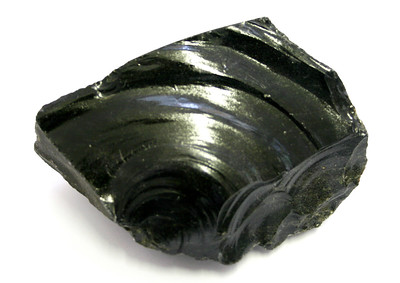Obsidian is shaped by quickly cooling felsic lava expelled from a volcano with restricted development in crystals. It is regularly found in the margins of rhyolitic lava streams known as obsidian streams, where the substance organization makes a high consistency resulting in the creation of natural glass from the lava after fast cooling. This exceptionally gooey lava’s inhibition of nuclear diffusion explains the absence of crystal development. Obsidian is unpleasant, delicate, and nebulous, with sharp edges breaking. It was utilized in the past to make obsidian arrowhead, blades, stick points, scrubbers, and numerous different weapons and devices.
Obsidian is mineral-like, yet not a genuine mineral since it isn’t crystalline as a glass; however, it is too intricate to possibly be sorted as a mineral. It is classified as a mineraloid once in a while. While obsidian is typically dim in color, like basalt-like mafic rocks, the piece of obsidian is incredibly felsic. Obsidian normally comprises 70% of silicon dioxide. Since obsidian is metastable on the outside of the Earth, no obsidian more established than the Cretaceous time frame has been found. The presence of water speeds up this cycle of obsidian. Despite the fact that the recently shaped obsidian has low water content, typically under 1 percent by weight, it is gradually hydrated to frame perlite when presented to groundwater.
How to identify obsidian?
The absence of a crystalline structure indicates that obsidian is certainly not a genuine mineral and causes outrageous sharpness of the crack surfaces. Since ancient occasions, obsidian has been utilized in cutting devices and is as yet utilized today in careful surgical tools.
Investigate obsidian where cooling is fast in the margins of lava streams. Glass Buttes in focal Oregon is perhaps the best spot to find obsidian in the U.S. Bits of clench hand size can be found on a superficial level in wealth here.
Examine the obsidian’s overall presence. It has a distinctive appearance of smooth glass. Obsidian is a solidified fluid that contains limited quantities of mineral pollutions.
See the color Because unadulterated obsidian is typically dull, on uncommon occasions, it might likewise be practically white.
Consider the impact of debasements on the obsidian color For models, iron, and magnesium may make obsidian dull green. Hematite or limonite includes a red or brown color to the obsidian. A great deal of tiny stone and mineral particles as a rule causes the ebony color most firmly associated with obsidian.
Looking at the obsidian’s enhanced visualizations of little gas bubbles. It can make the obsidian have a gold or silver shine if the air pockets were spread practically level.
What does obsidian feel like?
Obsidian has a solid conchoidal crack and radiance. It implies that the head of the break is curving easily. Obsidian seems, by all accounts, to be black. Minute inclusions and tiny crystals in the glass make its tint.
What are the qualities of obsidian?
Obsidian breaks with a commonplace “conchoidal” crack, like all glass and some different types of natural rocks. Because of the close to nonattendance of mineral crystals in the glass, this smooth, bent type of crack surface happens. Conchoidal crack surface intersections might be sharper than a knife.
What is the surface of obsidian?
Obsidian, a molten stone that happens as a natural glass delivered by the quick reward of gooey volcanic lava. Obsidian is incredibly silica-rich, low in the water, and has a rhyolite-like compound organization. Obsidian has a gloss of glass and is fairly more grounded than window glass.

